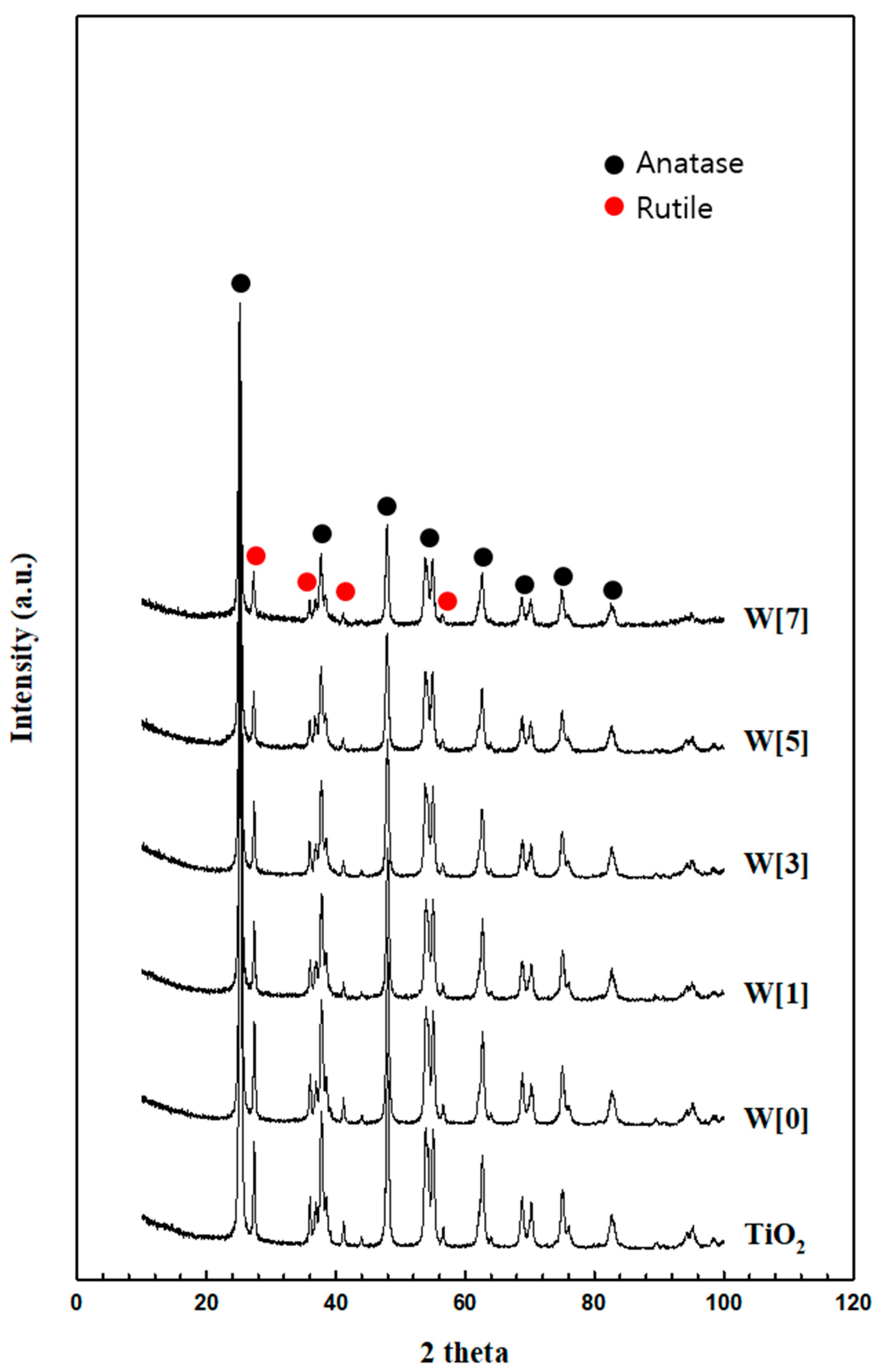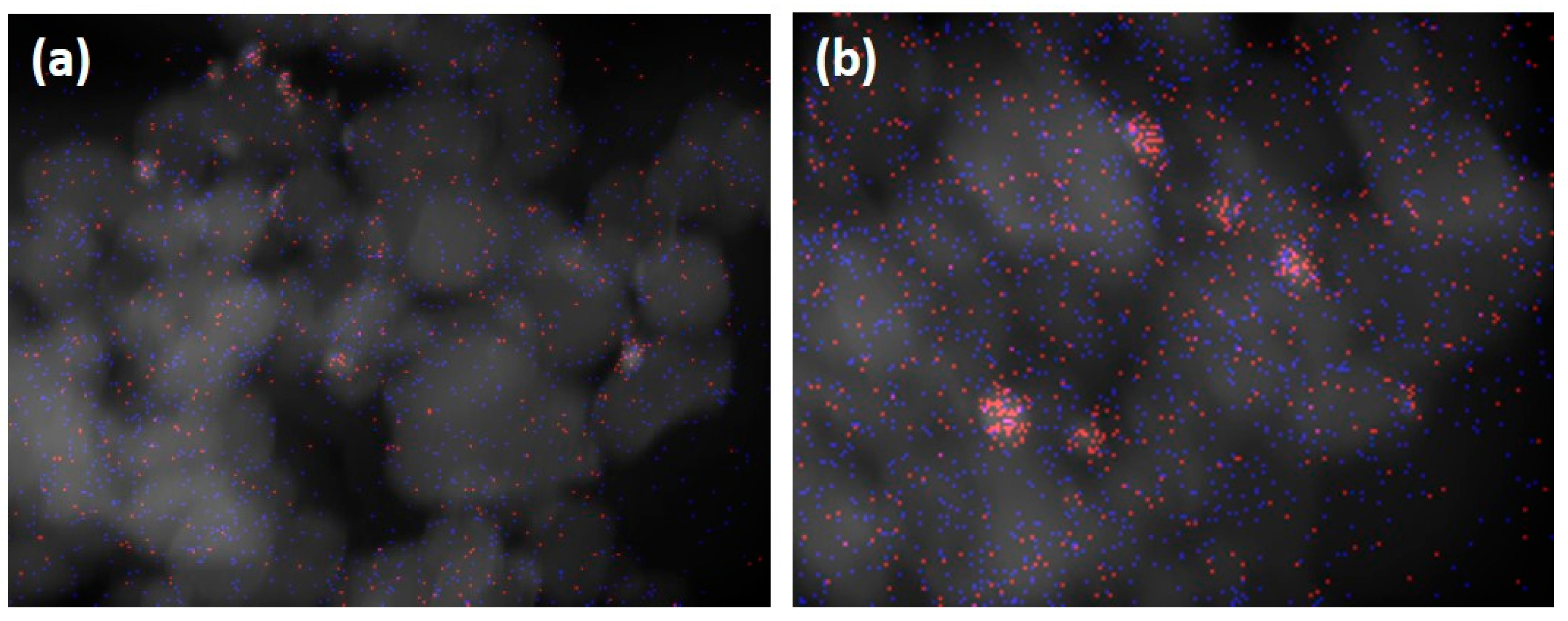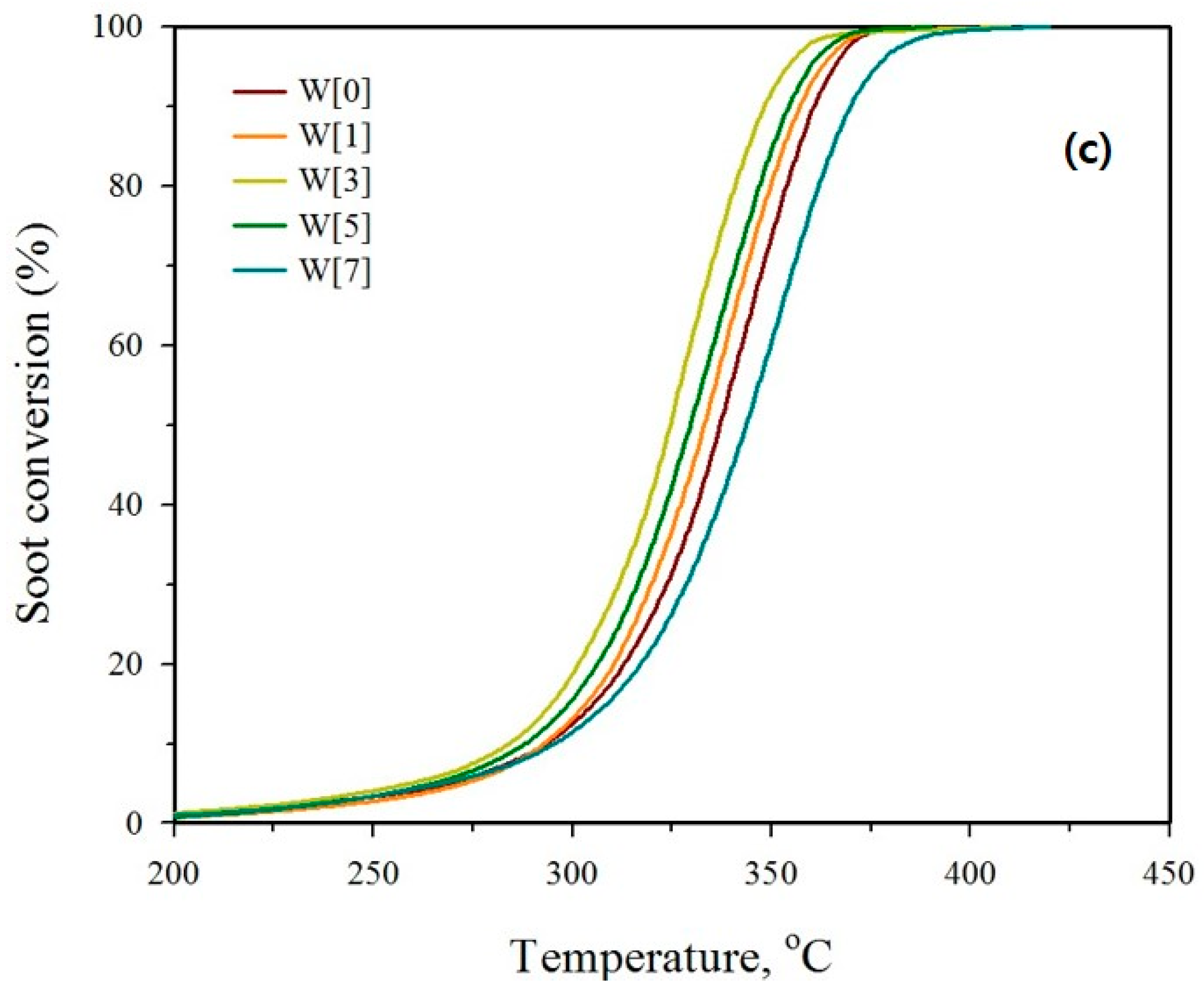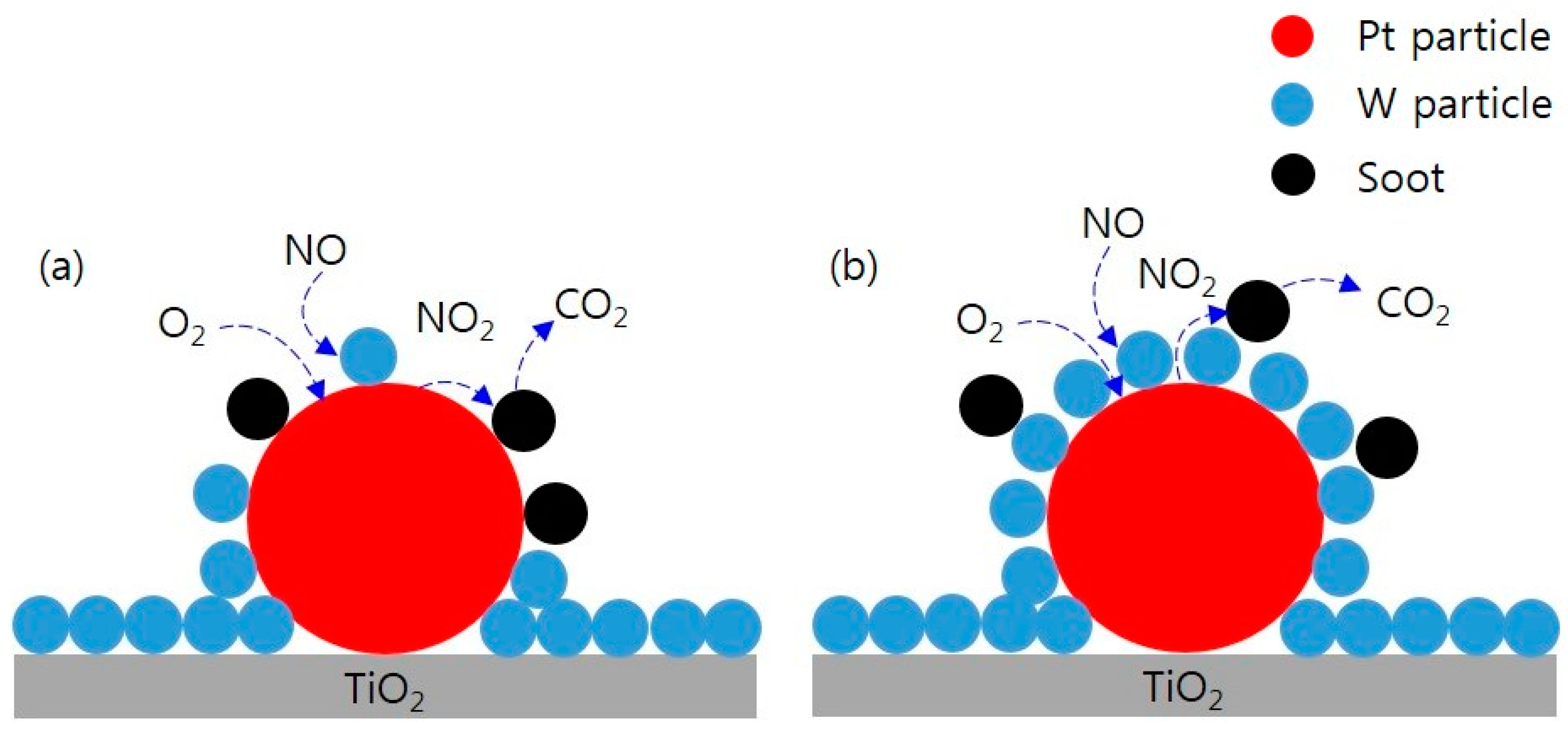Nitrogen Monoxide and Soot Oxidation in Diesel Emissions with Platinum–Tungsten/Titanium Dioxide Catalysts: Tungsten Loading Effect
Abstract
:1. Introduction
2. Results and Discussion
2.1. Catalyst Characterization
2.2. Catalytic Activities of Pt–W[x]/TiO2 for NO and Soot Oxidation
3. Materials and Methods
3.1. Catalyst Preparation
3.2. Experimental Apparatus and Evaluation Method
3.2.1. NO Oxidation
3.2.2. Soot Oxidation
3.3. Catalyst Characterization
4. Conclusions
Supplementary Materials
Author Contributions
Funding
Acknowledgments
Conflicts of Interest
References
- Caliskan, H.; Mori, K. Environmental, Enviroeconomic and Enhanced Thermodynamic Analyses of a Diesel Engine with Diesel Oxidation Catalyst (DOC) and Diesel Particulate Filter (DPF) after Treatment Systems. Energy 2017, 128, 128–144. [Google Scholar] [CrossRef]
- Jiao, P.; Li, Z.; Shen, B.; Zhang, W.; Kong, X.; Jiang, R. Research of DPF Regeneration with NOx-PM Coupled Chemical Reaction. Appl. Therm. Eng. 2017, 110, 737–745. [Google Scholar] [CrossRef]
- Birch, M.E.; Cary, R.A. Elemental Carbon-Based Method for Monitoring Occupational Exposures to Particulate Diesel Exhaust. Aerosol Sci. Technol. 1996, 25, 221–241. [Google Scholar] [CrossRef]
- Ko, J.; Jin, D.; Jang, W.; Myung, C.L.; Kwon, S.; Park, S. Comparative Investigation of NOx emission Characteristics from a Euro 6-Compliant Diesel Passenger Car over the NEDC and WLTC at Various Ambient Temperatures. Appl. Energy 2017, 187, 652–662. [Google Scholar] [CrossRef]
- Görsmann, C. Catalytic Coatings for Active and Passive Diesel Particulate Filter Regeneration. Monatsh. Chem. 2005, 136, 91–105. [Google Scholar] [CrossRef]
- Kandylas, I.P.; Koltsakis, G.C. NO2-Assisted Regeneration of Diesel Particulate Filters: A Modeling Study. Ind. Eng. Chem. Res. 2002, 41, 2115–2123. [Google Scholar] [CrossRef]
- Choi, B.; Lee, K.-S. LNT/CDPF Catalysts for Simultaneous Removal of NOx and PM from Diesel Vehicle Exhaust. Chem. Eng. J. 2014, 240, 476–486. [Google Scholar] [CrossRef]
- Oi-Uchisawa, J.; Wang, S.; Nanba, T.; Ohi, A.; Obuchi, A. Improvement of Pt Catalyst for Soot Oxidation Using Mixed Oxide as a Support. Appl. Catal. B 2003, 44, 207–215. [Google Scholar] [CrossRef]
- Matarrese, R.; Castoldi, L.; Lietti, L.; Forzatti, P. Soot Combustion: Reactivity of Alkaline and Alkaline Earth Metal Oxides in Full Contact with Soot. Catal. Today 2008, 136, 11–17. [Google Scholar] [CrossRef]
- Krishna, K.; Bueno-López, A.; Makkee, M.; Moulijn, J.A. Potential Rare-Earth Modified CeO2 Catalysts for Soot Oxidation Part II: Characterisation and Catalytic Activity with NO + O2. Appl. Catal. B 2007, 75, 201–209. [Google Scholar] [CrossRef]
- Liu, S.; Wu, X.; Weng, D.; Li, M.; Lee, H.-R. Combined Promoting Effects of Platinum and MnOx–CeO2 Supported on Alumina on NOx-Assisted Soot Oxidation: Thermal Stability and Sulfur Resistance. Chem. Eng. J. 2012, 203, 25–35. [Google Scholar] [CrossRef]
- Liu, S.; Wu, X.; Weng, D.; Li, M.; Ran, R. Roles of Acid Sites on Pt/H-ZSM5 Catalyst in Catalytic Oxidation of Diesel Soot. ACS Catal. 2015, 5, 909–919. [Google Scholar] [CrossRef]
- Gao, Y.; Yang, W.; Wu, X.; Liu, S.; Weng, D.; Ran, R. Controllable Synthesis of Supported Platinum Catalysts: Acidic Support Effect and Soot Oxidation Catalysis. Catal. Sci. Technol. 2017, 7, 3268–3274. [Google Scholar] [CrossRef]
- Liu, Z.; Lu, Y.; Yuan, L.; Ma, L.; Zheng, L.; Zhang, J.; Hu, T. Selective Catalytic Reduction of NOx with H2 over WO3 Promoted Pt/TiO2 Catalyst. Appl. Catal. B 2016, 188, 189–197. [Google Scholar] [CrossRef]
- Yu, L.; Shao, Y.; Li, D. Direct Combination of Hydrogen Evolution from Water and Methane Conversion in a Photocatalytic System over Pt/TiO2. Appl. Catal. B 2017, 204, 216–223. [Google Scholar] [CrossRef]
- Wu, X.; Liu, S.; Weng, D. Effects of Tungsten Oxide on Soot Oxidation Activity and Sulfur Poisoning Resistance of Pt/Al2O3 Catalyst. Catal. Sci. Technol. 2011, 1, 644–651. [Google Scholar] [CrossRef]
- Kim, S.S.; Park, K.H.; Hong, S.C. Correlation Research between Simultaneous Removal Reaction for NOx, Soot and Physico-Chemical Properties of Pt/TiO2’s Supports. Appl. Chem. Eng. 2010, 21, 178–182. [Google Scholar]
- Ruppert, A.M.; Paryjczak, T. Pt/ZrO2/TiO2 Catalysts for Selective Hydrogenation of Crotonaldehyde: Tuning the SMSI Effect for Optimum Performance. Appl. Catal. A 2007, 320, 80–90. [Google Scholar] [CrossRef]
- Ladera, R.; Finocchio, E.; Rojas, S.; Busca, G.; Fierro, J.L.G.; Ojeda, M. Supported WOx-Based Catalysts for Methanol Dehydration to Dimethyl Ether. Fuel 2013, 113, 1–9. [Google Scholar] [CrossRef]
- Hemmann, F.; Jaeger, C.; Kemnitz, E. Comparison of Acidic Site Quantification Methods for a Series of Nanoscopic Aluminum Hydroxide Fluorides. RSC Adv. 2014, 4, 56900–56909. [Google Scholar] [CrossRef] [Green Version]
- Seo, M.; Lee, D.-W.; Lee, K.-Y.; Moon, D.J. Pt/Al-SBA-15 Catalysts for Hydrocracking of C21–C34 n-Paraffin Mixture into Gasoline and Diesel Fractions. Fuel 2015, 143, 63–71. [Google Scholar] [CrossRef]
- Seo, M.; Kim, S.; Lee, D.-W.; Jeong, H.E.; Lee, K.-Y. Core–Shell Structured, Nano-Pd-Embedded SiO2–Al2O3 Catalyst (Pd@SiO2–Al2O3) for Direct Hydrogen Peroxide Synthesis from Hydrogen and Oxygen. Appl. Catal. A 2016, 511, 87–94. [Google Scholar] [CrossRef]
- Kanungo, S.; Keshri, K.S.; van Hoof, A.J.F.; d’Angelo, M.F.N.; Schouten, J.C.; Nijhuis, T.A.; Hensen, E.J.M.; Chowdhury, B. Silylation Enhances the Performance of Au/Ti–SiO2 Catalysts in Direct Epoxidation of Propene Using H2 and O2. J. Catal. 2016, 344, 434–444. [Google Scholar] [CrossRef]










| Catalyst | Feed | GHSV (h−1) a | Catalyst:Soot | T50 (°C) b | Ref. |
|---|---|---|---|---|---|
| Pt[1]/TiO2 | 550 ppm NO, 1.5 ppm SO2, 7.5% O2, 8% H2O, N2 bal. | 96,000 | 100:1 | 415 | [8] |
| Pt[1]/Al2O3 | 1000 ppm NO, 3% O2, He bal. | 30,000 | 9:1 | 550 | [9] |
| Pt[1]-K[5.4]/Al2O3 | 1000 ppm NO, 3% O2, He bal. | 30,000 | 9:1 | 450 | [9] |
| Pt[2.5]/CeO2 | 600 ppm NO, 10% O2, Ar bal. | 70,000 | 4:1 | 390 | [10] |
| Pt[0.5]/MnCeAl | 1000 ppm NO, 10% O2, N2 bal. | - | 10:1 | 442 | [11] |
| Pt[1]/H-ZSM5 | 1000 ppm NO, 10% O2, N2 bal. | 30,000 | 10:1 | 440 | [12] |
| Pt[1]/H-ZSM5 | 500 ppm NO, 10% O2, N2 bal. | 30,000 | 5:1 | 433 | [13] |
| Pt[1]-W[3]/TiO2 | 300 ppm NO, 3 ppm SO2, 10% O2, 5% H2O, N2 bal. | 50,000 | 4:1 | 324 | In this study |
| Sample | SBET (m2/g) | Sext (m2/g) | VP (m2/g) | DP (nm) |
|---|---|---|---|---|
| W[0] | 51.5 | 48.1 | 0.37 | 28.9 |
| W[1] | 54.1 | 49.5 | 0.37 | 27.5 |
| W[3] | 54.8 | 47.7 | 0.38 | 27.5 |
| W[5] | 54.7 | 46.4 | 0.35 | 25.9 |
| W[7] | 52.8 | 46.3 | 0.35 | 26.6 |
| Sample | Pt Loading (wt.%) a | Pt Dispersion (%) b | Pt Particle Size | |
|---|---|---|---|---|
| (nm) b | (nm) c | |||
| W[0] | 0.95 | 22.1 | 5.1 | 2.5 |
| W[1] | 0.98 | 17.1 | 6.6 | - |
| W[3] | 1.03 | 19.8 | 5.7 | 1.8 |
| W[5] | 0.94 | 8.8 | 12.8 | - |
| W[7] | 1.08 | 6.1 | 18.5 | 1.6 |
| Sample | Acid Site Density (mmolNH3 gCat−1) | |||
|---|---|---|---|---|
| Weak | Medium | Strong | Total | |
| W[0] | 0.078 | 0.080 | 0.071 | 0.229 |
| W[1] | 0.088 | 0.069 | 0.086 | 0.243 |
| W[3] | 0.083 | 0.059 | 0.091 | 0.233 |
| W[5] | 0.059 | 0.052 | 0.098 | 0.209 |
| W[7] | 0.057 | 0.046 | 0.073 | 0.176 |
| Sample | B-Acid Area (1640 cm−1) | L-Acid Area (1435 cm−1) | B/L Ratio b | Acid Site Density (mmolNH3 gCat−1) | ||
|---|---|---|---|---|---|---|
| Total a | Brønsted c | Lewis c | ||||
| W[0] | - | 8.03 | - | 0.229 | - | - |
| W[1] | 0.75 | 14.25 | 0.05 | 0.243 | 0.012 | 0.231 |
| W[3] | 0.92 | 15.95 | 0.06 | 0.233 | 0.013 | 0.220 |
| W[5] | 1.31 | 17.31 | 0.08 | 0.209 | 0.015 | 0.194 |
| W[7] | 2.15 | 18.50 | 0.12 | 0.176 | 0.018 | 0.158 |
Publisher’s Note: MDPI stays neutral with regard to jurisdictional claims in published maps and institutional affiliations. |
© 2020 by the authors. Licensee MDPI, Basel, Switzerland. This article is an open access article distributed under the terms and conditions of the Creative Commons Attribution (CC BY) license (http://creativecommons.org/licenses/by/4.0/).
Share and Cite
Oh, D.-k.; Lee, Y.-J.; Lee, K.-Y.; Park, J.-S. Nitrogen Monoxide and Soot Oxidation in Diesel Emissions with Platinum–Tungsten/Titanium Dioxide Catalysts: Tungsten Loading Effect. Catalysts 2020, 10, 1283. https://doi.org/10.3390/catal10111283
Oh D-k, Lee Y-J, Lee K-Y, Park J-S. Nitrogen Monoxide and Soot Oxidation in Diesel Emissions with Platinum–Tungsten/Titanium Dioxide Catalysts: Tungsten Loading Effect. Catalysts. 2020; 10(11):1283. https://doi.org/10.3390/catal10111283
Chicago/Turabian StyleOh, Duck-kyu, Young-Jae Lee, Kwan-Young Lee, and Jong-Soo Park. 2020. "Nitrogen Monoxide and Soot Oxidation in Diesel Emissions with Platinum–Tungsten/Titanium Dioxide Catalysts: Tungsten Loading Effect" Catalysts 10, no. 11: 1283. https://doi.org/10.3390/catal10111283






